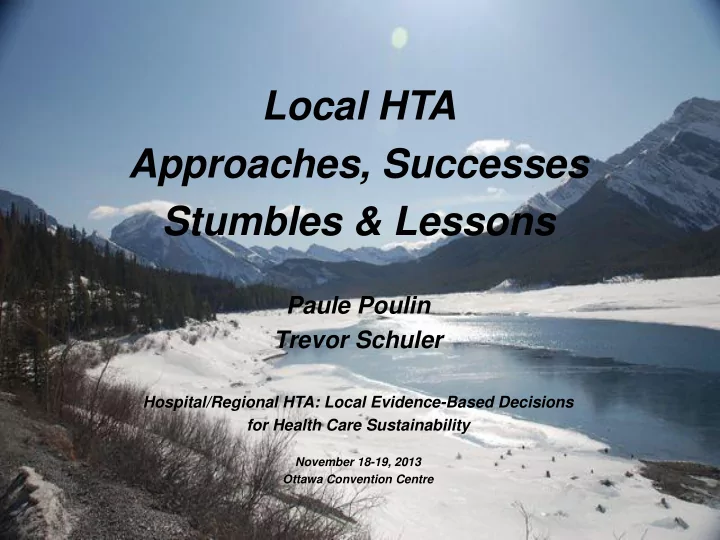

Local HTA Approaches, Successes Stumbles & Lessons Paule Poulin Trevor Schuler Hospital/Regional HTA: Local Evidence-Based Decisions for Health Care Sustainability November 18-19, 2013 Ottawa Convention Centre 1
Presentation Outline 1. Context – Background on Strategic Clinical Networks 2. Approach – Local HTA Decision Support Program 3. Successes – Evidence informed decision making 4. Challenges – Stumbles 5. Lessons Learned 2
Context: Strategic Clinical Networks What are SCNs? • Collaborative teams with a strategic mandate that bring together the perspectives of all stakeholders • Aimed at improving health care delivery – Alberta Quality Metrics for Health Acceptability, Accessibility, Appropriateness Effectiveness, Efficiency, Safety • Building sustainability 3
Why SCNs ? • Ensure collaboration & joint decision-making • Promote the use/uptake of research evidence • Share best practices across the province • Share knowledge, clinical experience and learning to reduce variation and improve care • Be involved in planning for health-care service delivery • Work together to develop new and innovative approach to care 4
Current SCNs Critical care Bone and Joint Cancer Cardiovascular Emergency Seniors and Stroke Obesity Addictions and Surgery Diabetes and Mental Health Nutrition 5
Who is involved in SSCN? Finance Senior Data Medical Integration, Scientific Leads Vice Management Director President & Reporting Patient (DIMR) Engagement Communications Quality and Assistant Healthcare Executive Scientific Improvement Director Director Admin Manager Assistant Local HTA Decision Community Clinical Support Program Engagement Engagement 6
2. Approach: Local HTA Decision Support Program 7
HTA Users: From Evidence to Decisions • • Local Local • • Local Local presence budget priority- population of trained impact….. setting health needs personnel NOW I HAVE HTA Reports DECISION WHAT NEXT? • Local • Local • Local alternatives infrastructure operations impact 8
Local HTA Program Components A. HTA Policy B. Local HTA Advisory Committee C. Forms to Gather Information D. Tools for Multi-Criteria Decision Making http://www.albertahealthservices.ca/4470.asp 9
Forms to Gather Information Support of Technology Technology Contract-Costing + + Request Request Check Form B Form A Form C Local HTA Committee Local HTA Check evaluation Form D MINOR CHANGE SIGNIFICANT CHANGE No significant clinical, contractual, cost or Uncertainties about clinical safety, effectiveness resource issues and/or cost or resources impact Clinical, Financial, or Referred Approved Economic Impact for further assessment for purchase/implementation Forms E-G 10
Tools for Multi-Criteria Decision Making Screening Guide Tool 1 SIGNIFICANT CHANGE MINOR CHANGE Uncertainties about clinical safety, effectiveness No significant clinical, contractual, cost or and/or cost or resources impact resource issues Referred Approved for further assessment For purchase/implementation Evaluation Criteria Tool 2 Recommendation Made by Local HTA Committee Recommendation Evaluation and Decision Guide Worksheet Decision Tool 4 Tool 3 Made by Executive Committee 11
Criteria for Evaluation 1. Description and Legal Domain (5) Criteria (12) 2. Health Gain Efficacy Population Health Standard of Care 3. Service Delivery Safety Training Access Service Coordination 4. Strategic Fit Strategic Fit 5. Innovation Knowledge & Research 6. Financial Cost Sustainability Economic Analysis 12
Recommendation and Decision Types 1. Rejected 2. Approved Recommendation Made by Local HTA Committee 3. Conditional Recommendation a. Single case and Decision Guide b. Clinical audit Tool 4 c. Other (e.g. training) Decision Made by Executive Committee 4. Research Use a. Clinical trial b. Support of project 5. Referred 13
Outcomes Reporting & Further Review SIGNIFICANT CHANGE Uncertainties about clinical safety, effectiveness and/or cost or resources impact Outcomes Referred reporting may for further assessment lead to further review Recommendation Made by Local HTA Committee Decision Outcomes Improvement Made by Executive Committee Reporting cycle 1. Approved 3. Conditional 2. Rejected 4. Research Use 5. Referred 14
3. Successes • Internal embedded to local environment -HTA requestor • Internal embedded HTA receptor • Multidisciplinary • Collaboration – CADTH • Education • Engagement • Optimal Use 15
4. Challenges (Stumbles) The Financial Stumble • Evaluation request from OR Manager regarding urinary incontinence technology • Review by CADTH • Evidence shows improved patient outcomes and estimated cost-saving to system • SSCN-HTA Committee • Recommended for specific patient population However, local OR Manager’s budget did not allow purchase 16
The Financial Stumble THE STUMBLE: • No good process for advancing money from potential cost-savings to the larger health care system to allow local purchase • Similarly, who should realize the benefits of cost- savings? • Incentive?? 17
The Implementation Stumble • Laser Tx for tissue removal • Reviewed and shown to be safe, effective & cost effective • Approved for funding by Alberta Health • Approved for purchase by AHS However, tried, but abandoned for lack of improved Local outcomes 18
The Implementation Stumble THE STUMBLE: • Lack of training resulted in lack of improved outcomes • No systematic implementation or training plan 19
The Outcomes Stumble • Technologies given recommendations for purchase based on our criteria • But – did they actually deliver? 20
The Outcomes Stumble THE STUMBLE: • No outcomes measures built into the implementation plan when technology are approved • Often very difficult to do 21
The Organizational Stumble • HTA processes require education and support of many members in a health care organization • Many hours of effort given to educational sessions, workshops, and building relationships • Relationships lost when positions change 22
The Organizational Stumble THE STUMBLE: • Constantly shifting organizational structures means losing educated HTA champions and relationships 23
5. Lessons Learned • HTA Education – undergraduate medical and nursing education • Engagement & collaboration • Embedded & Integrated • Built incentive for sustainability • Share budget responsibilities • Opportunity Cost • Outcomes measures 24
Acknowledgement Surgery Strategic Clinical Network CADTH Research Portfolio Local HTA Decision Support Program developers AI-HS collaborators 25
For More Information Contact Paule Poulin │ (403) 944 - 1652 │ paule.poulin@albertahealthservices.ca http://www.albertahealthservices.ca/4470.asp 26
Putting it All Together Health Gain Service Delivery Could a switch to CHG- alcohol have a significant impact on the prevention of SSI in Alberta? Strategic Fit Financial Innovation 27
Recommend
More recommend